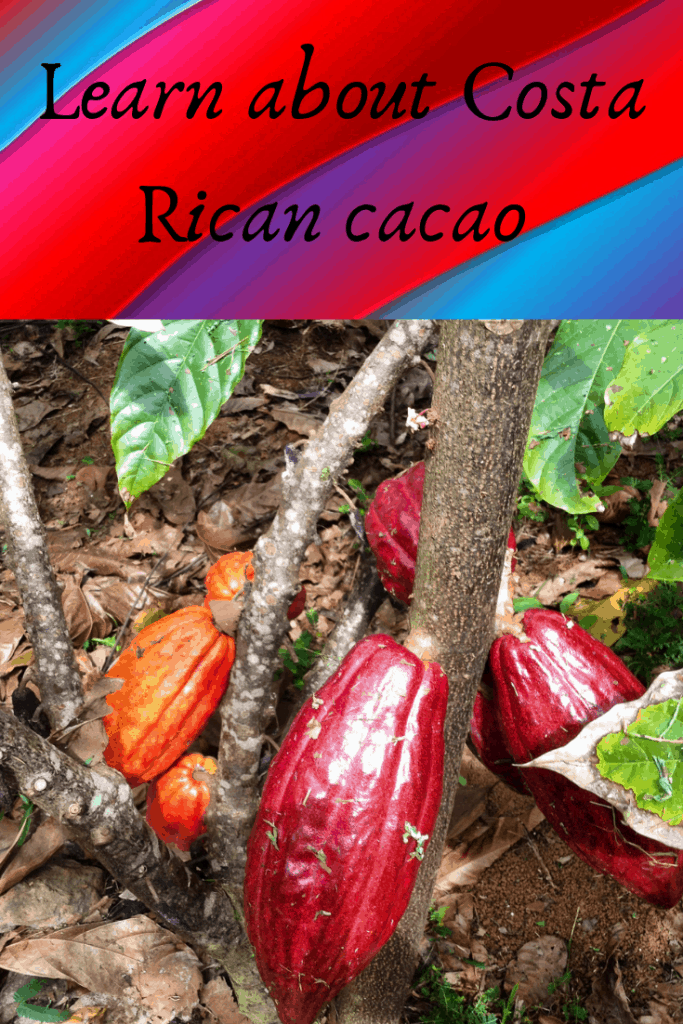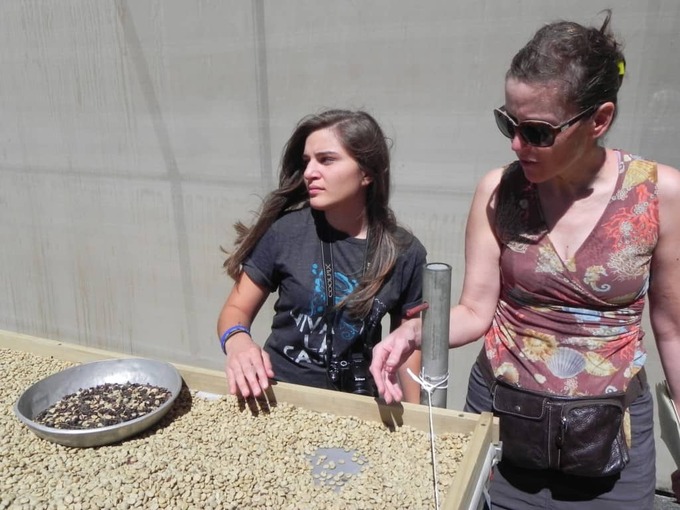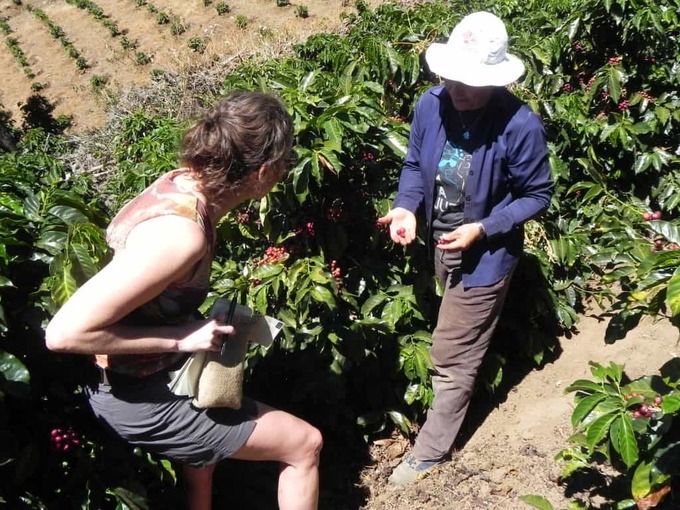This week, we have the great pleasure of welcoming guest blogger Merle Rosenstein to the blog. I know Merle through the Professional Writers Association of Canada. We both share a love of travel, and a love for fine coffee. As Merle has just returned from Costa Rica, where she visited a number of coffee plantations, she has been generous to offer us insight into what she saw and tasted. Please welcome Merle with the same warmth we’ve come to know here on the blog.
Cupping Specialty Coffee in Costa Rica
Hello chocolate enthusiasts! I’ve been reading Doreen’s delicious accounts of her chocolate travels and wanted to share with you a guest post on coffee travel. Coffee is the number one beverage in Canada after non-bottled water and a favourite morning pick-me-up. But there’s more to coffee than most people know. For example, did you know that coffee is more complex than wine and has over 850 aromatic compounds? On a recent trip to Costa Rica, I sampled coffee cherry directly from the bush, talked with farmers and pickers about a new picking paradigm, witnessed the washing, pulping and drying processes and ‘cupped’ micro-lots of coffee alongside experts.
In February, Francisco Mena of Exclusive Coffees, a boutique coffee exporter, took me to two farms in the lush, mountainous West Valley, a key agricultural district in Costa Rica. The Helsar de Zarcero micro mill is located on a high ridge in the area of Alajuela, in the coffee areas of Zarcero and Naranjo. At the Mill I met the very gracious Ricardo Perez and his charming daughter, who walked me through the washing and drying stations.
The washing process removes the pulp surrounding the bean in preparation for drying. On a massive cement patio, white coffee beans baked in the hot sun. The beans felt smooth and dry to the touch, but were not ready yet. Fully-washed beans are patio-dried for two days and placed on African beds for eight days. I watched as a worker examined the beans resting in elevated wood frames covered in netting.
Perez drove me over to Finca Don Chepe to meet farmer Manuel Arce and his wife Lorena. Plots of coffee bushes lined a valley on the property, planted in a similar configuration to grape vines. I traversed the steep slippery slope to greet the Nicaraguan and Panamanian pickers. The workers pick coffee cherry by hand and drop them into baskets called cajuelas.
Lorena invited me to sample some fully ripe coffee cherry. The ruby red cherries were very sweet. The ripest coffee cherry make the best tasting coffee.
Then Francisco Mena took me back to his office/warehouse to cup coffee with some coffee roasters from Crema Coffee in Nashville, in Costa Rica on a buying trip. The coffee tasting or ‘cupping’ process is very intricate and involves smelling and tasting a number of different coffee samples, set up in a circle. As I walked around the table trying each sample, I could detect different tasting notes or complexity in each. Three sample coffees were selected and prepared in the espresso maker as a final test. The coffees were fragrant and full bodied, full of complex aromas.
Both coffee and cacao are major crops in Costa Rica. If you’d like to join me on a small group tour during which we’ll learn all about cacao and other crops in Costa Rica, please join me January 11-19, 2020, for a customized Chocolatour with Go Ahead Tours.




Thank you for sharing. If you’re in search of high-quality coffee beans, I recommend checking out High Noon Roasters. It’s considered the best online coffee store. For further details, please visit their website.
https://highnoonroasters.com/
Thanks for sharing. If you’re on the lookout for premium-quality coffee beans, I strongly suggest considering High Noon Roasters. They are well-known for delivering outstanding coffee that consistently meets the highest standards of quality and flavor.
https://highnoonroasters.com/
Fantastic article on cupping specialty coffee in Costa Rica! If you’re a coffee enthusiast looking to savor the flavors of Costa Rica, consider trying High Noon Roasters for Costa Rica coffee delivery service. Their exceptional Costa Rican coffee will transport your taste buds to this beautiful coffee-growing region.
Thanks for the post. I love to read this post. this really enjoyable post. I am a coffee lover. so I gladly accept your info.
Great post Doreen. I’m always learning something new about coffee when I read your blog
Good post! I love learning so much about my favorite beverage. I want to go on a coffee travel too.
Hi Mike and welcome to the blog! We generally focus on chocolate travel on this blog, but the cool thing is that coffee and cocoa generally grow in the same places. 🙂
I love it! i knew some things about coffee but now I know much, much more. I do love a good cup of coffee and seek out the best whenever I have an occasion. Cupping coffee is kind of like a tasting wine except a bit noisier… LOL. You really can tell the difference when you really take the time to taste its fullness of flavor. Thanks so much for sharing this.:-)
If you are interested in specialty coffee in Canada, you can read my li paper, Specialty Coffee in Canada on Twitter @merlerosenstein. To learn more about my travels, you can subscribe to my blog http://www.newfreelancewriter.wordpress.com .
Costa Rica coffee is definitely the best! Well… in my biased opinion 🙂 There’s a smoothness and body that you don’t get with most coffees. Britt makes some of the best Costa Rican coffee that is exported, but it’s not easy to find in the US. Every time we visit CR, we always bring back ten bags for us or loved ones. Nice read!
Hi Jason: Yes, I’ve had Britt coffee — and chocolate! Both are very good. Thanks for dropping by the blog.
Yes, Britt chocolate is also excellent! Thanks!
I always wanted to drink an authentic Costa Rica coffee. It must have a nice and unique aroma and taste!
It does indeed, Agness! Exploring the different coffees of the world is like exploring the different wines — and chocolate — of the world! It tastes different according to the terroire (location and conditions) in which it’s grown. Thanks for stopping by. Always great to hear from you. 🙂
As a huge coffee fan, I’m stunned by the varieties and the compounds. No wonder we love it so much – first with the nose.
Thanks for your comment, Renee. Yes, coffee is just like chocolate (cacao) in that its marvellous taste can be attributed to the complexity of the flavour and aroma compounds. There’s a another new guest post on the blog today. I hope you’ll check it out!
Very interesting article.
Did know there are many types of coffee from different countries but I did not know that coffee is more complex than wine and has over 850 aromatic compounds.
Internet is wonderful because it enables us to learn so much every day about subjects we normally may not have looked into:-)
Thanks for your comment, Catarina. Yes, the internet is sure a great resource for teaching us everything we need and want to know about pretty much everything!
I, too, was surprised by the revelation that there are 850 aromatic compounds in coffee! But come to think about it, nothing smells better than a fresh pot of fine coffee. Enjoy!
Hi Suzanne,
The coffee bushes at Finca Don Chepe grow on the steep slope of a mountain and machines couldn’t be used. Hand-picking is also necessary to sort out the ripe coffee cherry from the coffee cherry that are not yet ripe. Coffee picking takes place several times a season.
I visited K’au on the Hilo side of the Big Island and tasted some excellent coffee there. My dad lives on the Big Island so I try and visit often.
We traveled to Hawaii last month and visited two coffee farms on the Big Island of Hawaii near Kona—as in Kona coffee. In Hawaii, most of the coffee is picked by machine. Something tells me that the Costa Rican farms would frown on this.
Thanks for your message, Suzanne! And welcome to the blog. I believe it is your first time here.
How I want to go to the Big Island. I do love the Kona coffee. But it’s the chocolate I want to go for! One of these days …
Thanks for the enlightening post on a process I’ve never given much though to until now, though I’ve always been happy to enjoy my daily cup of gigantic coffee every morning. I can certainly see how coffee can be just as fascinating, if not more so, than wine.
Seems there’s so much more to coffee than meets the eye. Although I knew a bit about coffee, I had no idea that it has over 850 aromatic compounds. Interesting read!
Thanks for your comment, Salika. Yes, I was surprised at the 850 compounds of coffee as well. Chocolate has 400 chemical compounds and I thought that was a lot!
There are different coffee varietals too, just like in wine.
Thanks for your comments, Cheryl and Susan. It’s always great having you join us.
I love it! i knew some things about coffee but now I know much, much more. I do love a good cup of coffee and seek out the best whenever I have an occasion. Cupping coffee is kind of like a tasting wine except a bit noisier… LOL. You really can tell the difference when you really take the time to taste its fullness of flavor. Thanks so much for sharing this.:-)
Glad you enjoyed it.
Wow… lots to learn about coffee. I can’t believe how many blogs I have read where I am learning something new and fascinating. 🙂
There is a lot to learn about coffee and that’s why it’s so fascinating. There’s a long chain of events from growing the beans to brewing a quality cup. And baristas are the ambassadors of specialty coffee.